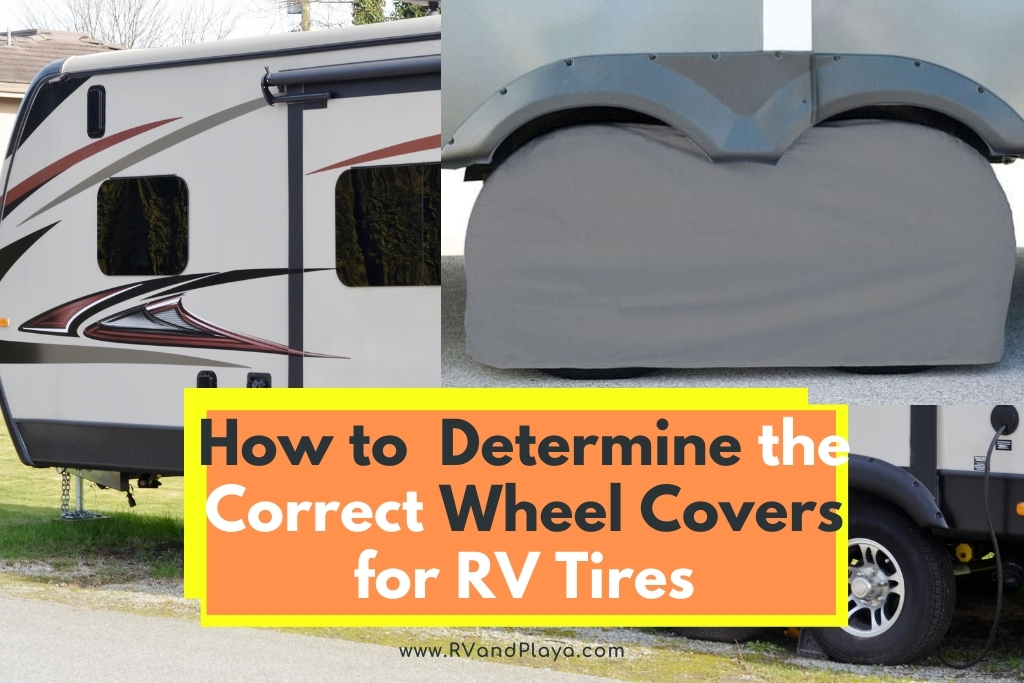Have you ever wondered how to easily determine the correct wheel covers for your RV tires? Well, you are now the proud new owner of an RV! Congratulations! Certainly, the next thing you want to do is get on the road!
But before you do, you should take every precaution you can to protect your RV, including taking care of your tires.
You want something to protect your tires for years to come since there are so many things that can damage them.
How to determine the correct wheel covers for your RV tires? There are a few steps to make sure to put into consideration when getting wheel covers, such as:
- Size of your tires
- Reading a tire sidewall
- Following a wheel cover chart
But how exactly do you determine which wheel cover to use? After all, when you look at the tire, all you see are a bunch of numbers and letters.
While other guides might try and sell a certain tire cover, this article will explain just how to determine the size of your tire and then picking out the right size cover for you; all without having to go to the RV store first!
Table of Contents
How to Easily Determine The Correct Wheel Covers for RV Tires
First you need to know the numbers off your current RV tires. In general to determine the tire size or tire dimension, you need 3 part like 205/75-R15 (see picture below).
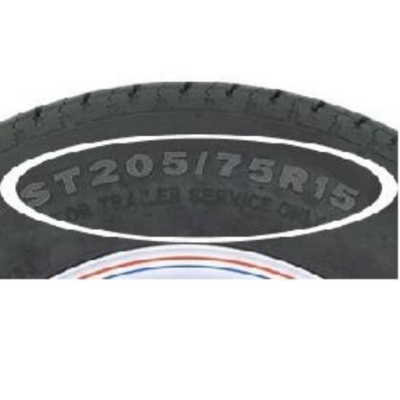
1. Determine The Tire Width
The first number “205” represent the tire section width in millimeters. To calculate in inches, you need to divide the number by 10 and the result you divide by 2.54 (1 inch =2,54)
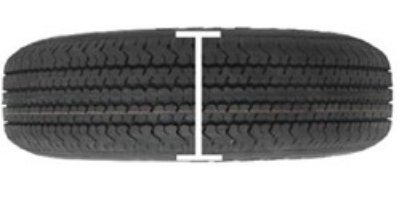
In our example we have 205/100 = 20,5 and we take the result “20,5” and divide by 2,54. We now have 20,5/2,54 = 8,07 inches
Related reading: LT vs. ST Tires for Travel Trailers: What Works Better?
2. Determine The Tire Section Width
The second number “75” represent sidewall aspect ratio which is a percentage of the tire section width.
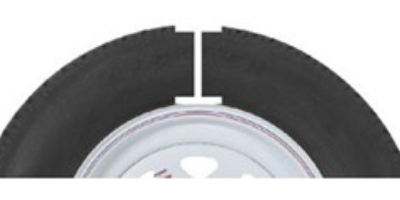
In our specific example, we have 75% of 205mm equal 153mm or inches we should have 75% of 8,07 inches = 0,75×8,07 inches= 6,05 inches
3. Determine The Wheel Diameter
The 3rd part “R15” represent the diameter of the wheel (in inches) on which the tire is mounted.
In our tire example 205/75-R15 the wheel diameter is “15”
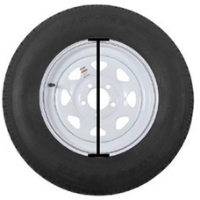
4. Determine The Wheel Covers Size
Now to determine the total diameter (from the wheel + the tire section) you need to add the wheel diameter to the tire section height (2x because we have 2 sections height)
Total tire diameter = 15 inches + 2x 6,05 inches = 27,1 Inches
27,1 inches is the diameter of the wheel covers you need. But due to some tolerance you should take 1-2 inches bigger. In our case I will recommend a wheel covers of 27”-29” would be a better fit.
Related reading: How to Choose the Perfect Cover for Your Travel Trailer [Read This First]
4. Examples of Wheel Covers For RV Tires
In the table below you can find the correct wheel covers you need for your RV tires base on specific tire size:
TABLE
| RV Tire Size | Recommended RV Wheel Covers Size | Example Products |
|---|---|---|
| 225/75R16 | 30″ to 32″ | Adco Ultra Tyre Gard RV Wheel Covers – Single Axle – 30″ to 32″ – Vinyl |
| ST205/75R14 | 24″ to 26″ | Adco Ultra Tyre Gard RV Wheel Covers – Single Axle – 24″ to 26″ – Vinyl |
| ST205/75R14 (spare tire) | 25-1/2″- 26 -1/2″ | Classic Accessories Custom Fit Spare Tire Cover – Model 3 25-1/2″- 26 -1/2″ Snow White |
| 245/70R19.5 | 33″ to 35″ | Adco Ultra Tyre Gard RV Wheel Covers – Single Axle – 33″ to 35″ – Vinyl |
| LT215/85-R16 | 30″ to 32″ | Adco Ultra Tyre Gard RV Wheel Covers – Single Axle – 30″ to 32″ – Vinyl |
| 225/75R15 | 27″ to 29″ | Adco Ultra Tyre Gard RV Wheel Covers – Single Axle – 27″ to 29″ – Vinyl |
| 255/80R22.5 | 33 to 35″ | Adco Ultra Tyre Gard RV Wheel Covers – Single Axle – 33″ to 35″ – Vinyl |
| ST205/75R15 | 27″ to 29″ | Adco Ultra Tyre Gard RV Wheel Covers – Single Axle – 27″ to 29″ – Vinyl |
| 4.80×12 Tires Mounted On the Trailer | 19″ to 22″ | Classic Accessories RV Wheel Covers – 19″ to 22″ |
| Trailer with Tire Size 205/75-14 | 27″ to 29″ | Adco Ultra Tyre Gard RV Wheel Covers – Single Axle – 27″ to 29″ – Vinyl |
| 22inch tires on my Class A motor Home | 19″ – 22″ | Classic Accessories RV Wheel Covers – Model 0 19″ – 22″ |
| 2017 Keystone Passport Ultra Light RV camper with 275R14 tires | 24″- 27″ | Classic Accessories RV Wheel Covers – Model 2 24″- 27″ Gray |
| LT225/75R16 for 2019 Thor Quantum Class C Motorhome | 30″ to 32″ | Adco Ultra Tyre Gard RV Wheel Covers – Single Axle – 30″ to 32″ – Vinyl |
| Kenda Trailer Tire # AM30620 | 19″ to 22″ | Classic Accessories RV Wheel Covers – 19″ to 22″ – Gray |
| Rockwood Pop-Up Camper with 145R12 Tires | 19″ to 22″ | Classic Accessories RV Wheel Covers – 19″ to 22″ – Gray |
| Kenda 205/65-10 Bias Trailer Tire with 10″ White Wheel – 5 on 4-1/2 – Load Range E | 19″ to 22″ | Classic Accessories RV Wheel Covers – 19″ to 22″ |
| Spare Tire Cover for 18.5×8 Spare Tire on a Triton Boat Trailer | 19″ to 22″ | Classic Accessories RV Wheel Covers – 19″ to 22″ – Gray |
How to Determine the Size of Your Tires
Just how large your tires are is going to be the main factor in determining what kind of cover you are going to need.
There are a few ways to determine tire size, and this depends upon if you bought your RV brand new off the lot or it is used.
For those that bought a brand new RV, it is going to come with original manufacturer’s parts, which include all the same tires.
Around the vehicle, there are going to be placards that display important information about the RV. Some of the information included will be about the size of the tires. These placards are typically found in some of the following places:
- By the driver’s seat
- In the glove box
- Inside the gas tank cover
For those people that bought a used RV, there should be placards in those locations as well, but they might not be accurate.
That is because one or more of the tires could have been changed out since the RV was first purchased. In that case, an owner must look at the sidewall of a tire to ensure that the information is the most up to date.
New owners can also do so to verify, but the placard will list the exact same information as it appears on the sidewall.
How to Read a Tire sidewall
The first step might sound easy, but it is a little more complicated than what first meets the eye. When looking at any tire, including an RV tire, you are going to see a series of numbers and letters.
Reading from left to right, the first letter is going to be the type of tire. For every RV tire, that is going to be a P for passenger since all RVs are passenger vehicles.
However, this information will not affect its size.
The next number is going to be the width of the tire and is a measurement taken from sidewall to sidewall. The length, as stated in a three-digit number, is in millimeters and is the first number that is going to be important in determining size.
The next two numbers after the slash are going to be what is called the aspect ratio. The aspect ratio is a comparison between the sidewall height and tire width as a percentage.
Do not get too wrapped up in what it is, but understand it is the second number that you will need.
Next, there is going to be a letter. For most RV tires, this will be the letter “R” and simply denotes how the layers of the tire are put together, which in this case means radially down the length of the tire.
Right after this letter is the third number, you will need, and that is the diameter. The diameter is measured from one end of the tire to the other and is measured in inches.
Why is this Information Important?
Making sure that you have, at a minimum, the width of the tire, the aspect ratio, and the diameter will help you determine what kind of cover you need.
If you do not have this information, you will not be able to use the conversion charts that have been created to match the size of the RV tire to the corresponding wheel cover.
If you do not pick the right wheel cover, it might be too small, which would not allow you to put it on.
On the other hand, the cover might be too big, and it is equally as ineffective since it would allow water, snow, oil, or debris to get in between your cover and tire.
Therefore, having these three pieces of information will now allow you to pick your cover.
Picking Your Wheel Cover
To pick your cover, there are a variety of charts out there that list the size of your tire in one column then recommend the size of the wheel cover in the other. Wheel covers do not come in as specific sizes as tires do.
Wheel covers have their own measurement system that ranks them as sizes in the alphabet.
The size comparisons can be tricky since there are no standard charts, and these will vary from company to company.
One common chart, for example, lists the sizes of tires from size A, the smallest, to size Y, the largest. While others use the opposite scale by listing A as the largest and O as the smallest.
To read one of these charts, there are a few ways to read them. The first way is by seeing which chart has the range of the width of your tire in it.
From there, you can go down the line to make sure your tire is listed. Some other charts list the sizes per letter as the width in inches compared to the diameter in inches.
Before purchasing a tire cover, it is important to know which scale the company uses so that you can accurately read it before buying it.
Other Considerations
There are a few other factors to consider before buying a wheel cover. One of those is whether you have a single or double axel RV. Wheel covers are specially made to fit either one of these configurations.
However, some users report that even with a two axel vehicle, wheel covers made for single tires are easier to install and are better at keeping debris out from between the cover due to the loose area in-between the tires that remain vulnerable.
The type of environments you expect to be in or store your vehicle for long periods will also affect what kind of wheel cover to buy. If you live in hot, sunny areas, wheel covers that offer UV protection from the sun might be better for you.
However, if you live in areas with lots of rain or snow, getting a waterproof cover might be the better option.
How Do I Keep My Trailer Tires From Dry Rotting?
Dry rotting refers to the cracking and splitting of the sidewall or treads of your RV tires. As your tires age, they may become brittle, and your chances of having a blowout or a leak become much higher.
Although manufacturers try and blend chemicals to resist dry rot by adding carbon black to the rubber and adding waxes to prevent UV damage, your tires are still at risk.
The most significant cause of dry rotting is exposure to the UV rays of the sun. Tires undergo Thermo oxidative degradation from the sun, which is more severe in hot climates.
If your RV is stored on black asphalt or other heat-absorbing surfaces, the sun’s harmful effects are accelerated.
Other dry rot causes are prolonged periods of inactivity and low tire pressure. Improperly inflated tires can wear out prematurely and pose safety problems.
Owners should always refer to their RV manufacturers recommended tire pressure levels. Owners should ensure that their tire pressure is checked often and that the RV is driven regularly.
To prevent dry rotting of your RV tires, you should:
- Keep your tires out of direct sunlight wherever possible and invest in tire covers when storing your RV outdoors
- Move your RV regularly from storage to flex your tires. The movement helps the protective waxes to move up to the surface of your tires
- Do not use tire protectants that use petrochemicals or silicone oils that may strip your tire’s protective waxes and speed up the possibility of dry rot
- Place boards under your tires if stored outdoors to reduce contact with the asphalt that can retain high temperatures and attract UV rays
- Some RV forums suggest that your RV is raised from the ground and the tires placed in storage if the RV will not be used for 60 days or more. This method has its potential risks, and it is not recommended by RV experts unanimously.
Should RV Tires Be Off The Ground?
Most RV enthusiasts agree that short-term storage of an RV would not necessitate the tires be elevated from the ground.
Should RV tires be off the ground? Yes, If you plan to leave your RV longer than 45-60 days, you should consider raising the tires off the ground. RV owners should ensure that some kind of barrier is in place to protect their tires from contact with the ground, such as wood or heavy-duty plastic tire mats.
Prolonged contact with the ground and the RV weight on your tires may lead to dry rot or lat spotting, which is when the tire develops a flat spot.
The surface of the ground where you store your RV is an essential factor in whether you will need to raise your tires or not. Grass and wet areas can degrade your tires considerably due to moisture damage.
When you are planning long term storage, it is suggested that you raise your tires off the ground. There are some risks due to suspension components that are not made to be hung from their frame for extended periods.
Using a jack stem for storage can cause other problems while ostensibly protecting their RV tires. Jacking an RV on four corners can affect your coach’s structure by providing no support to the RV’s central section.
Many RV forums claim to have safe elevation systems fro their RVs, but you should consider the potential risks to your RV if you chose to use this method.
To protect your tires during periods of inactivity, you should follow the following prompts:
- Ensure your tires are covered to reduce UV exposure
- Keep your RV as level as possible as an uneven weight on your tires can cause abnormal wear and increases the danger of tire failure
- Keep your tires off the ground during extended storage
- Keep your tires inflated to the Manufacturer’s specifications
- Inspect your tires often and especially before travel
- Move your RV periodically to flex the tires form their fixed position
- Replace your tires every 4-6 years according to your tire specifications.
Do You Need Wheel Chocks For A Motorhome?
Do you need wheel chocks for a motorhome? Yes, although parking brakes work to keep your RV from moving, wheel chocks are added insurance that your RV or travel trailer is adequately secured. Chocks provide stability to your parked RV and keep your vehicle from slipping and reducing excess movement when moving inside your parked RV.
Chocks are especially crucial on uneven or steep surfaces and work best in combination with air brakes.
Chocking your camper trailer and 5th wheel is essential because there is no parking brake to provide proper stability when parked.
Chocks are relatively inexpensive and easy to transport, and the added security could potentially cause thousands of dollars in damages should your RV, 5th Wheel, or travel trailer should move from its parked position.
Smaller RVs may need only 1 or 2 chocks, but larger motorhomes may need four, depending on the vehicle’s weight and the incline gradient when parked.
Your owner manual will usually provide information regarding the number of chocks necessary to ensure safe parking.
How Long Does A Tire Last In Storage?
If your tires are stored in a climate-controlled environment, they can achieve an almost unlimited shelf life. Due to the costs of having a climate-controlled storage area, most people would choose normal storage conditions.
How long does a tire last in storage? In the case of regular storage, experts recommend replacing your tires after six years of storage regardless of the tread state. Older tires may suffer from the rubber compounds degenerating over time and may pose a risk even if there is no visible damage.
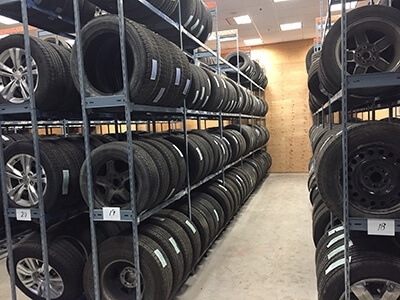
Some tire companies warn that even tires that are not in use should be replaced every six years.
In the US, there have been lawsuits pursued against vehicle owners using tires past their 6-year limit that have caused accidents.
The replacement date is particularly essential because compromised tires may not exhibit any outward signs of their degeneration.
What Is The Best RV Cover For Winter?
Winter conditions have specific requirements when protecting your RV. If your RV will be outside for the winter, it is especially important to protect your vehicle from wind damage, tree sap, and bird droppings.
Your RV cover should be made of high-quality polyester or polypropylene, which are water-resistant while still providing breathability.
These covers are excellent for battling snow and hail and low temperatures.
Your cover will prevent snow and ice build-up and avoid meltwater from creeping between the seams between panels and components or your RV.
Plastic traps will trap moisture and will trend to flap in the wind and cause exterior damage. You should find a cover made specifically for your climate and for your RV model so that it fits snugly.
You need a firmly strapped cover to keep the moisture out of your RV.
What Are The Best RV Tire Covers?
A high-class waterproof vinyl is the best choice when it comes to RV wheel covers.
Not only do they increase the lifespan of your tires from UV damage, but they also protect from harsh weather conditions.
UV rays cause Thermo oxidative degradation, which the most significant cause of dry rotting and cracking of tire sidewalls.
OverDrive RV ; Trailer Wheel Cover are an excellent example of what you should look for in an RV wheel cover. The high-quality waterproof vinyl not only protects from external damages but has a non-scratching inner that protects the tire from friction.
The vinyl is also easy to wipe clean and is elasticized and secured with an eyelet system that ensures a snug fit.
Final Thoughts
Before buying a wheel cover for your RV, the most important information in determining your wheel size first.
Then, you need to be able to translate that information to the correct size wheel cover on a variety of different sizing charts companies use.
Lastly, you need to consider the number of axels and environments as the ultimate deciding factors once you have determined the right size of wheel cover to offer maximum protection.
Recommended Reading
You might want to check out our other articles about RVing for more information.
How to Choose the Perfect Cover for Your Travel Trailer [Read This First]
What Does RV Insurance Cover? A Comprehensive Guide
Can You Use Truck Tires on Travel Trailers?
Does RV Insurance Cover Water Damage? What You Need To Know
Will A Regular Queen Mattress Fit In A Camper? – What To Consider
LT vs. ST Tires for Travel Trailers: What Works Better?
Sources
https://www.etrailer.com/question-257591.html
https://tirecovers.com/tire-size-charts.html
https://www.etrailer.com/question-100596.html
https://www.tirebuyer.com/education/how-to-read-off-road-tire-sidewalls
Recent Posts
Is Toyota Remote Connect Free? (Subscription, Services Plans)
Does Toyota Remote Connect have an included trial? It used to be the case that, when you bought a new car, you made one straightforward payment and that was it. Now, it feels like there are...
Toyota Safety Connect: What It Is And Why You Need It? Whether you’re buying a new Toyota or you’ve had one for a while you will have been given the hard sell on their Connected Services but do...

